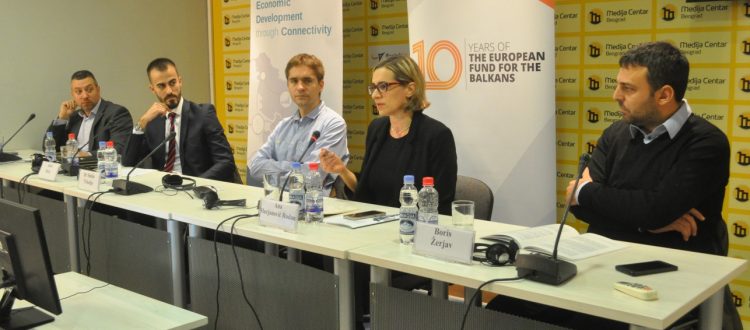Connectivity for Development – taking the highway for economic growth
A panel discussion to promote the regional study, ‘Connectivity for Development – Taking the Highway for Economic Growth’, was organized in Belgrade.
| Suggested Reading | Conflict Background | GCCT |
The report is available in English by clicking here.
The report is available in Serbian by clicking here.
A panel discussion to promote the regional study, ‘Connectivity for Development – Taking the Highway for Economic Growth’, was organized in Belgrade. The study is the main result of a joint Think and Link Project in Serbia, Kosovo* and Albania, implemented by Democracy for Development (D4D), the European Movement in Albania and TransConflict, and supported by the European Fund for Balkans. During the course of the study, researchers analyzed transport and energy projects in Serbia, Kosovo* and Albania, implemented within the Connectivity Agenda framework. In 2015, the European Commission allocated €1b in subsidies by 2020 to support the “Western Balkans Connectivity Agenda” from the EU Instrument for Pre-Accession Assistance.
Ana Marjanović Rudan, of the European Fund for Balkans, explained the role of Connectivity Agenda within the Berlin Process that has been going on since 2014, stressing that much more progress has been made with achieving the stated economic goals, than with the political ones. A representative of D4D, Allen Meta, presented the structure of the study, a regional overview of the results and recommendations for policy-makers. Among the main problems pinpointed by the study are bilateral problems between Kosovo* and Serbia, as well as a lack of funds and administrative capacities of the relevant institutions. The study researcher for Serbia, Boris Žerjav, gave more details about the seven ongoing infrastructure projects in Serbia – five in the transport and two in the energy sector.
According to Žerjav, connectivity projects in Serbia are mainly focused on improving existing, and completing missing, parts on the rail and road Corridor X, since it accounts for around 25% of the country’s total rail networks and over 50% of all its rail transport. Finally, a representative of the Ministry of Construction, Transport and Infrastructure, Dr. Siniša Trkulja, provided deeper insight into the process of planning and infrastructure project implementation. In particular, Dr Trkulja explained the planning and the construction process of the Niš-Merdare highway, for which a Spatial Plan of the Area of Special Interest was developed this year. The panel was moderated by Vladimir Ninković of TransConflict Serbia.
The research study has been published in English, Serbian and Albanian language and can be downloaded from the partner organization websites.
The views expressed in this article do not necessarily reflect the views of TransConflict.



















